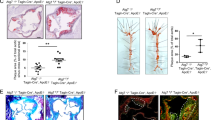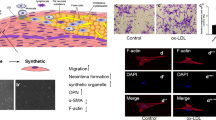Abstract
Hyperhomocysteinemia (HHcy) is a highly-related risk factor in vascular smooth muscle cell (VSMC) phenotypic modulation and atherosclerosis. Growing evidence indicated that autophagy is involved in pathological arterial changes. However, the risk mechanisms by which homocysteine and VSMC autophagy interact with cardiovascular disease are poorly understood. This study verified the homocysteine-responsive endoplasmic reticulum protein promotion of VSMC phenotypic switching, and the formation of atherosclerotic plaque in vitro. We found that impaired autophagy, as evidenced by decreased levels of MAP1LC3B II/MAP1LC3B I, has a vital role in HHcy-induced human aortic (HA)-VSMC phenotypic switching, with a decrease in contractile proteins (SM α-actin and calponin) and an increase in osteopontin. Knockdown of the essential autophagy gene Atg7 by small interfering RNA promoted HA-VSMC phenotypic switching, indicating that impaired autophagy induces phenotypic switching in these cells. HHcy co-treatment with rapamycin triggered autophagy, which alleviated HA-VSMC phenotypic switching. Finally, we found that Krüppel-like factor 4 (KLF4), a zinc-finger transcription factor for maintaining genomic stability by resisting oxidative stress and restoring autophagy, is closely involved in this process. HHcy clearly decreased KLF4 expression. KLF4-specific siRNA aggravated defective autophagy and phenotypic switching. Mechanistically, KLF4 regulated the HHcy-induced decrease in HA-VSMC autophagy via the m-TOR signaling pathway. In conclusion, these results demonstrated that the KLF4-dependent rapamycin signaling pathway is a novel mechanism underlying HA-VSMC phenotypic switching and is crucial for HHcy-induced HA-VSMCs with defective autophagy to accelerate early atherosclerosis.







Similar content being viewed by others
Abbreviations
- HHcy:
-
Hyperhomocysteinemia
- Hcy:
-
Homocysteine
- VSMC:
-
Vascular smooth muscle cell
- HA-VSMC:
-
Primary human aortic vascular smooth muscle cells
- m-TOR:
-
Mammalian target of rapamycin
- KLF4:
-
Krüppel-like factor 4
References
Barquilla A, Navarro M (2009) Trypanosome TOR as a major regulator of cell growth and autophagy. Autophagy 5(2):256–258
Castino R, Davies J, Beaucourt S, Isidoro C, Murphy D (2005) Autophagy is a prosurvival mechanism in cells expressing an autosomal dominant familial neurohypophyseal diabetes insipidus mutant vasopressin transgene. FASEB J 19(8):1021–1023
Chappell J, Harman JL, Narasimhan VM, Yu H, Foote K, Simons BD, Bennett MR, Jørgensen HF (2016) Extensive proliferation of a subset of differentiated, yet plastic, medial vascular smooth muscle cells contributes to neointimal formation in mouse injury and atherosclerosis models. Circ Res 119(12):1313–1323
Chen Y, Zhang H, Liu H, Li K, Su X (2018) Homocysteine up-regulates ET B receptors via suppression of autophagy in vascular smooth muscle cells. Microvasc Res 119:13–21
Cheng G, Jia G, Agrawal DK (2007) Autophagy of vascular smooth muscle cells in atherosclerotic lesions. Autophagy 3(1):63–64
Chistiakov DA, Orekhov AN, Bobryshev YV (2015) Vascular smooth muscle cell in atherosclerosis. Acta Physiol 214(1):33–50
Grootaert MO, Da Costa Martins PA, Bitsch N, Pintelon I, De Meyer GR, Martinet W, Schrijvers DM (2015) Defective autophagy in vascular smooth muscle cells accelerates senescence and promotes neointima formation and atherogenesis. Autophagy 11(11):2014–2032
Guo X, Shi N, Cui X, Wang J, Fukui Y, Chen S (2015) Dedicator of cytokinesis 2, a novel regulator for smooth muscle phenotypic modulation and vascular remodeling. Circ Res 116(10):e71–e80
He C, Zhu H, Zhang W, Okon I, Wang Q, Li H, Le Y, Xie Z (2013) 7-Ketocholesterol induces autophagy in vascular smooth muscle cells through Nox4 and Atg4B. Am J Pathol 183(2):626–637
He M, Zheng B, Zhang Y, Zhang X, Wang C, Yang Z, Sun Y, Wu X, Wen J (2015) KLF4 mediates the link between TGF-β1-induced gene transcription and H3 acetylation in vascular smooth muscle cells. FASEB J 29(9):4059–4070
Hill BG, Haberzettl P, Ahmed Y, Srivastava S, Bhatnagar A (2008) Unsaturated lipid peroxidation-derived aldehydes activate autophagy in vascular smooth-muscle cells. Biochem J 410(3):525–534
Jiang C, Zhang H, Zhang W, Kong W, Zhu Y, Zhang H, Xu Q, Li Y, Wang X (2009) Homocysteine promotes vascular smooth muscle cell migration by induction of the adipokine resistin. Am J Physiol-Cell Physiol 297(6):C1466–C1476
Jin P, Bian Y, Wang K, Cong G, Yan R, Sha Y, Ma X, Zhou J, Yuan Z, Jia S (2018) Homocysteine accelerates atherosclerosis via inhibiting LXRα–mediated ABCA1/ABCG1–dependent cholesterol efflux from macrophages. Life Sci 214:41–50
Kabeya Y, Mizushima N, Yamamoto A, Oshitani-Okamoto S, Ohsumi Y, Yoshimori T (2004) LC3, GABARAP and GATE16 localize to autophagosomal membrane depending on form-II formation. J Cell Sci 117(Pt 13):2805–2812
Lin H, Ni T, Zhang J, Meng L, Gao F, Pan S, Luo H, Xu F, Ru G, Chi J, Guo H (2018) Knockdown of Herp alleviates hyperhomocysteinemia mediated atherosclerosis through the inhibition of vascular smooth muscle cell phenotype switching. Int J Cardiol 269:242–249
Liu C, DeRoo EP, Stecyk C, Wolsey M, Szuchnicki M, Hagos EG (2015) Impaired autophagy in mouse embryonic fibroblasts null for Kruppel-like factor 4 promotes DNA damage and increases apoptosis upon serum starvation. Mol Cancer 14:101
Lu Q, Harris VA, Kumar S, Mansour HM, Black SM (2015) Autophagy in neonatal hypoxia ischemic brain is associated with oxidative stress. Redox Biol 6:516–523
Lü S, Deng J, Liu H, Liu B, Yang J, Miao Y, Li J, Wang N, Jiang C, Xu Q, Wang X, Feng J (2018) PKM2-dependent metabolic reprogramming in CD4 + T cells is crucial for hyperhomocysteinemia-accelerated atherosclerosis. J Mol Med 96(6):585–600
Mei Y, Thompson MD, Cohen RA, Tong X (2015) Autophagy and oxidative stress in cardiovascular diseases. Biochim et Biophys Acta (BBA) 1852(2):243–251
Murgai M, Ju W, Eason M, Kline J, Beury DW, Kaczanowska S, Miettinen MM, Kruhlak M, Lei H, Shern JF, Cherepanova OA, Owens GK, Kaplan RN (2017) KLF4-dependent perivascular cell plasticity mediates pre-metastatic niche formation and metastasis. Nat Med 23(10):1176–1190
Nakano S, Ishii I, Shinmura K, Tamaki K, Hishiki T, Akahoshi N, Ida T, Nakanishi T, Kamata S, Kumagai Y, Akaike T, Fukuda K, Sano M, Suematsu M (2015) Hyperhomocysteinemia abrogates fasting-induced cardioprotection against ischemia/reperfusion by limiting bioavailability of hydrogen sulfide anions. J Mol Med 93(8):879–889
Rosenfeld ME (2015) Converting smooth muscle cells to macrophage-like cells with KLF4 in atherosclerotic plaques. Nat Med 21(6):549–551
Sarkar S, Ravikumar B, Floto RA, Rubinsztein DC (2009) Rapamycin and mTOR-independent autophagy inducers ameliorate toxicity of polyglutamine-expanded huntingtin and related proteinopathies. Cell Death Differ 16(1):46–56
Shankman LS, Gomez D, Cherepanova OA, Salmon M, Alencar GF, Haskins RM, Swiatlowska P, Newman AAC, Greene ES, Straub AC, Isakson B, Randolph GJ, Owens GK (2016) Erratum: Corrigendum: KLF4-dependent phenotypic modulation of smooth muscle cells has a key role in atherosclerotic plaque pathogenesis. Nat Med 22(2):217
Song P, Wang S, He C, Wang S, Liang B, Viollet B, Zou M (2011) AMPKα2 deletion exacerbates neointima formation by upregulating Skp2 in vascular smooth muscle cells. Circ Res 109(11):1230–1239
Sun X, Tong H, Zhang M, Wang XH (2012) Rosuvastatin inhibits the smooth muscle cell proliferation by targeting TNFalpha mediated Rho kinase pathway. J Geriatr Cardiol 9(2):180–184
Tripathi M, Zhang CW, Singh BK, Sinha RA, Moe KT, DeSilva DA, Yen PM (2016) Hyperhomocysteinemia causes ER stress and impaired autophagy that is reversed by Vitamin B supplementation. Cell Death Dis 7(12):e2513
Tyagi N, Qipshidze N, Munjal C, Vacek JC, Metreveli N, Givvimani S, Tyagi SC (2012) Tetrahydrocurcumin ameliorates homocysteinylated cytochrome-c mediated autophagy in hyperhomocysteinemia mice after cerebral ischemia. J Mol Neurosci 47(1):128–138
Wang H, Jiang X, Yang F, Gaubatz JW, Ma L, Magera MJ, Yang X, Berger PB, Durante W, Pownall HJ, Schafer AI (2003) Hyperhomocysteinemia accelerates atherosclerosis in cystathionine beta-synthase and apolipoprotein E double knock-out mice with and without dietary perturbation. Blood 101(10):3901–3907
Wang Y, Zhao B, Zhang Y, Tang Z, Shen Q, Zhang Y, Zhang W, Du J, Chien S, Wang N (2012) Krüppel-like factor 4 is induced by rapamycin and mediates the anti-proliferative effect of rapamycin in rat carotid arteries after balloon injury. Br J Pharmacol 165(7):2378–2388
Xu K, Yang Y, Yan M, Zhan J, Fu X, Zheng X (2010) Autophagy plays a protective role in free cholesterol overload-induced death of smooth muscle cells. J Lipid Res 51(9):2581–2590
Yan F, Liu Y, Liu Y, Zhao Y (2008) KLF4: a novel target for the treatment of atherosclerosis. Med Hypotheses 70(4):845–847
Yang F, Chen Q, He S, Yang M, Maguire EM, An W, Afzal TA, Luong LA, Zhang L, Xiao Q (2018) miR-22 is a novel mediator of vascular smooth muscle cell phenotypic modulation and neointima formation. Circulation 137(17):1824–1841
Zhan J, Wang Y, Wang Y, Tang Z, Tan P, Huang W, Liu Y (2014) Adiponectin attenuates the osteoblastic differentiation of vascular smooth muscle cells through the AMPK/mTOR pathway. Exp Cell Res 323(2):352–358
Acknowledgements
This research was sponsored by grants from the National Natural Science Foundation of China (Grant No. 81873120), the 325 Talent Plan of Zhejiang Province (Grant No. 2017.10), and the Provincial Ministry of Construction Project of Zhejiang Province (Grant No. WKJ-ZJ-1729).
Author information
Authors and Affiliations
Corresponding authors
Ethics declarations
Conflict of interest
The authors declare that they have no conflicts of interest.
Additional information
Publisher's Note
Springer Nature remains neutral with regard to jurisdictional claims in published maps and institutional affiliations.
Rights and permissions
About this article
Cite this article
Ni, T., Gao, F., Zhang, J. et al. Impaired autophagy mediates hyperhomocysteinemia-induced HA-VSMC phenotypic switching. J Mol Hist 50, 305–314 (2019). https://doi.org/10.1007/s10735-019-09827-x
Received:
Accepted:
Published:
Issue Date:
DOI: https://doi.org/10.1007/s10735-019-09827-x




